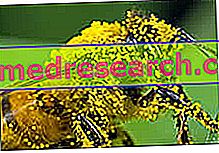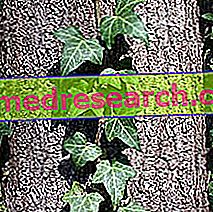What is Pollen
Pollen is a fine and sticky powder that is the fertilizing matter of flowers.
For this reason it is a characteristic element, a sort of different genetic imprint for each type of flower.

Since the bees, during their normal foraging activity, collect pollen from a large variety of flowers, it is not possible to know the exact chemical composition; the data reported in this article are therefore indicative.
Precisely because of its nutritional completeness, bee pollen is used as a nutritional supplement.
Indications
Why do we use bee pollen? What is it for?
Pollen is a true concentrate of proteins, present at a rate of 30% and made up of all eight essential amino acids for humans.
In addition to these, twenty of the twenty-two alpha-amineocides of alimentary interest are also present in free form.
Each grain of pollen contains about 35% of glucides (in particular glucose and fructose) which, together with the abundant content of trace elements and vitamins, make it a complement with remarkable energetic and revitalizing properties.
The fatty substances, on the other hand, are present in an average percentage of 5% and being mainly composed of unsaturated fatty acids, they are particularly useful for the well-being of the organism.
The vitamin content is particularly high, so much so that only one spoonful of pollen is able to cover the daily requirement of many vitamins on its own; the only ones absent are vitamin F (essential fatty acids) and B4 (adenine), among other things not properly considered vitamins.
Also the mineral salts (phosphorus, potassium, magnesium, calcium, silicon, manganese, copper, iron, sodium, chromium and zinc) are well represented.
The completeness and complexity of its components, together with the popular medical tradition, make pollen a dietary supplement useful in the treatment and prevention of numerous, pathological and non-pathological conditions (anemia, arteriosclerosis, asthenia, capillary fragility, colitis, depression, diabetes, weight loss, eczema, flu, tired eyes, prostatitis, rheumatism, constipation and varicose veins). Its adaptogenic virtues make it useful for improving the body's adaptation and response to various types of stressful events.
The use of pollen is also widespread in the sports field, where its richness in minerals, vitamins and amino acids is appreciated.
Although many people, after having tried it, confirm the healing and revitalizing properties of the pollen, there is no certain evidence that they attest to its efficacy in the sports field, much less in the therapeutic field. According to what has been said so far, pollen can still be reasonably considered a valid and complete natural alternative to synthetic multivitamin and multimineral supplements.
Property and Effectiveness
What benefit has Bee Pollen shown during the studies?
As mentioned, most studies on the benefits of bee pollen have been conducted on experimental and animal models.
In the latter, regular use of bee pollen would have ensured a marked improvement in the functionality of the immune system, an improvement in the blood chemistry parameters of the laboratory and in general an important action to improve the quality of life.
However, noteworthy clinical evidence is lacking.
Doses and method of use
How to use bee pollen
Fasting is the best time to consume pollen, which can be taken, for example, before breakfast or between meals.
The classically used doses vary depending on the product, going from gram to 10 grams daily.

The minimum duration of each treatment varies from one to three months: the longer it lasts, the more the dosage can be reduced to a maintenance value.
Pollen can be marketed in pearls, tablets or, more simply, in the natural state in the form of many small "balls" packaged directly by the bees. As mentioned at the beginning of the article, the more the colors are different (from ivory white to gray, to yellow, to greenish, to red, to brown, to black), the more the varieties of pollen consumed and their effects will be expanded.
Side effects
The incidence of side effects related to the consumption of bee pollen tends to grow significantly in allergy sufferers.
In these the appearance of itching, rhinitis, conjunctivitis, bronchospasm and in only two cases hepatotoxicity was frequently observed.
Instead, hypereosinophilia and neurological symptoms are decidedly rarer.
Contraindications
When should bee pollen not be used?
Pollen is contraindicated for allergy sufferers, which could cause severe problems even if ingested without being inhaled (for example in the form of pearls); if its origin is not controlled, as often happens for non-EU products, the risk of contamination with pesticides must also be assessed.
Pollen consumption can lead to laxative effects and, thanks to its mild stimulating effect, but not irritating, on the sluggish intestine, can help to fight constipation.
The use of pollen as a supplement is also contraindicated in the pediatric age, during pregnancy, and in the subsequent period of breastfeeding.
Pharmacological Interactions
Which drugs or foods can modify the effect of bee pollen?
Not known drug interactions are currently known.



